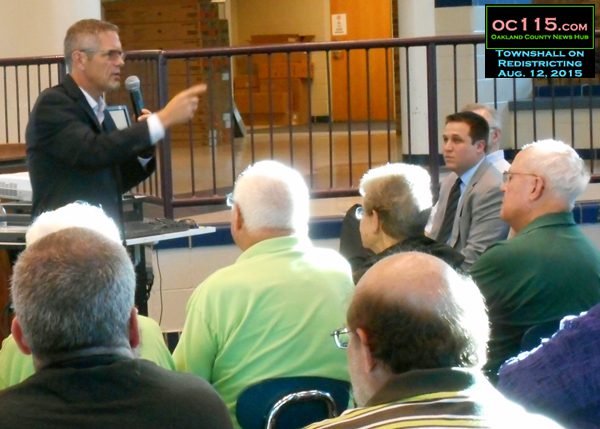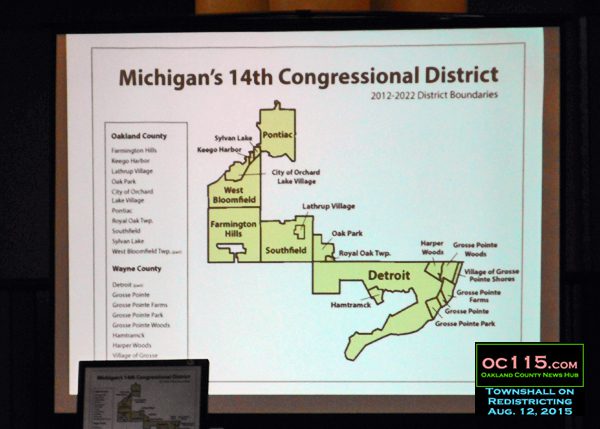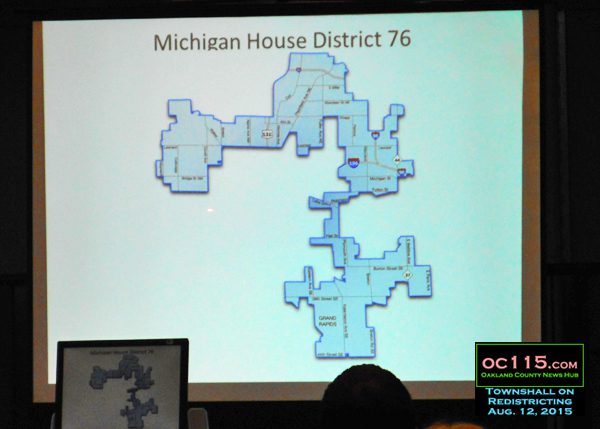 Townhall
Townhall  Explores Possibility of Redistricting Reform
Explores Possibility of Redistricting Reform
(Crystal A. Proxmire, Aug. 15, 2015)
“When I was in junior high, there was this famous editorial cartoon in the textbook about Gerrymandering, and it had this oddly chopped up district that was shaped like a monster or a dragon. It was like this big joke that back in the old days they used to do this terrible, undemocratic thing that we look back on and laugh at. Except this isn’t something they just used to do in 1812. People are shocked to learn this is how things are done today,” said Dave Smith, a former Pleasant Ridge City Commissioner after sitting in on a town hall meeting about redistricting.
The cartoon he referred to shows the original “gerrymander,” a name made-up  of the politician responsible for the odd district, and the salamander-like shape that district made on the map.
of the politician responsible for the odd district, and the salamander-like shape that district made on the map.
The Redistricting Townhall was held Wednesday in Berkley by State Representative Robert Wittenberg, who introduced someone working on a national campaign to change the process of redistricting, and an expert in the issue from a Michigan perspective.
Former Congressman Mark Schauer, who unsuccessfully ran against Governor Rick Snyder in the 2014 election, is now working for Advantage 2020, a Super PAC of Democrats working on how best to get redistricting laws changed across the county, including in Michigan.
Mark Brewer, election law attorney with Goodman Acker and former Chair of the Michigan Democratic Party, focused on what issues Michigan faces specifically. He talked about a nonpartisan effort that is coming together for changing Michigan’s rules.
changing Michigan’s rules.
All three shared the same belief that the system for drawing district lines is flawed by having elected officials getting to pick and choose their voters. “There is too much politics in it, and not enough fairness,” Wittenberg said.
District lines are re-drawn following each census, and there are rules to make each district relatively close in population size. In an ideal world, districts would be fair and would make sense to geographic areas. However with such a politicized process, the lines are often drawn for political advantage rather than fair representation.
“In 2014, Democrats received 51% of the votes, but Republicans gained four seats and 57% control of the House,” Schauer said. “In 2014 Democrats received 57% of the votes for Congress, but 64% of Michigan’s Congressional Delegation  is Republican.”
is Republican.”
Michigan’s 14th Congressional District is one of the nation’s most notoriously gerrymandered districts. It goes from Downtown Detroit and snakes through the suburbs and into Pontiac, compacting as many traditionally Democratic votes into one District as possible so as to give Republicans in surrounding districts a better shot. When Gary Peters represented the 14th District, his home was five miles outside the 8th district, 15 houses away from the 11th district and 500 yards outside the 14th district. Brenda Lawrence now serves those voters.
Redistricting can happen at the county and city level as well. Pontiac voters recently voted against a charter revision that would have changed the number of districts in the city. And Oakland County was redistricted in 2012 as  Republicans decided to reduce the total number of seats from 25 to 21, essentially eliminating Democratic votes.
Republicans decided to reduce the total number of seats from 25 to 21, essentially eliminating Democratic votes.
The challenge of redistricting reform is that the party in power easily deflects conversations by dismissing those efforts as part of the game, or a power play by the underdog. “If the effort is by a political party, then people say ‘oh well, it’s a partisan food fight’ and they don’t want to get into it,” Brewer said. He said that in many states it’s been nonpartisan groups like the League of Women Voters or Common Cause that have taken the lead on pushing for change.
Brewer explained that successful reform has happened in other places, and he shared commonalities between those efforts. “They were led by nonpartisan groups,” he said. “They were inclusive, diverse coalitions that include African Americans, Hispanics, Arab Americans, people of different backgrounds.” Lastly  the reforms were generally long-term efforts and not just band-aid fixes.
the reforms were generally long-term efforts and not just band-aid fixes.
Some options include having an independent commission draw the districts and putting in requirements that those who draw the lines follow the Constitution of the United States and the Voting Rights Act. Most efforts had safeguards against partisan gerrymandering and ensured that those involved were not partisan, and that the goal of drawing districts was to create level playing fields for interested candidates.
In Ohio there is a bipartisan commission and the boundaries are required to be based on the statewide preferences of voters. In Florida redistricting is prohibited from favoring any political party. And in Arizona they are required to draw the districts competitively.
“There’s a lot to be said about what’s going on in Arizona,” Brewer said. “The  districts swing back and forth, it seems to be working how they envisioned.”
districts swing back and forth, it seems to be working how they envisioned.”
One point that came from a member of the audience was that when districts are drawn heavily Republican or heavily Democratic, the people who run for those seats are not trying to appeal to middle of the road Americans, but to the extreme ends of the party’s donors and voters.
So the question became how can redistricting reform be done. “The legislature could vote to change it, but they’re not going to,” Brewer said. He explained that change could come through the Federal court system, if people wanted to challenge maps based on racial gerrymandering. The most likely way though would be through a State Constitutional Amendment that would have to be put  on the ballot and voted on by the people.
on the ballot and voted on by the people.
“I think this has to be a citizen initiative for this to happen,” Wittenberg said. “I don’t think this is a partisan issue and I hope people on both sides of the aisle can get behind it. I am a Democrat but for me this is about equity for all voters.” For a measure to make it to the ballot, it would need 320,000 signatures. Citizen initiatives can only go on the ballot in even years, so 2016 or 2018 would be the target to have the measure pass before the 2020 Census. Brewer said petitioning would be done in June and July of that year.
Schauer said he “had a hunch” that there might be some “well-funded opposition” to reform efforts, similar to those the surfaced during right to work
Among the citizens in the audience were elected officials from multiple  communities including Farmington Hills, Ferndale, Huntington Woods, Pleasant Ridge, Hazel Park and Berkley.
communities including Farmington Hills, Ferndale, Huntington Woods, Pleasant Ridge, Hazel Park and Berkley.
Berkley Mayor Phil O’Dwyer shook his head as the presenters showed examples of gerrymandering and its impact. “The current situation disenfranchises the people. Districts need to be designed in such a way as voters have a reasonable chance of electing a Democrat or a Republican. Currently it’s a foregone conclusion. I think if people think this is unfair, they should take this up and put it on the ballot for a vote.”
To learn more about the Democratic Legislative Campaign Committee Advantage 2020 initiative, see http://dlcc.org/news/dlcc-launches-advantage-2020-key-success-next-round-redistricting-70-million-plus-effort.








